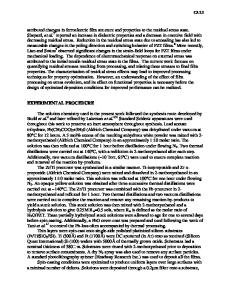Measurement of Residual Stress in ZnO Thin Films Deposited on Silicon Wafers by the Indentation Fracture Test
- PDF / 145,657 Bytes
- 6 Pages / 612 x 792 pts (letter) Page_size
- 89 Downloads / 341 Views
U3.3.1
Measurement of Residual Stress in ZnO Thin Films Deposited on Silicon Wafers by the Indentation Fracture Test Tong-Yi Zhang and Bin Huang Department of Mechanical Engineering Hong Kong University of Science and Technology Clear Water Bay, Kowloon, Hong Kong, China ABSTRCT The indentation fracture test was used to evaluate residual stress in ZnO thin films deposited on silicon wafers. Using the calibrated constants involved in a simple semi-empirical formula, which was developed based on fracture analysis and experimental results, we estimated the residual stress in the ZnO thin films by measuring the indentation-induced crack length as a function of the indentation load. INTRODUCTION Thin films on semiconductor substrates are of special interest to the microelectronic industries. Thin films have, in general, properties that are different from their bulk counterparts. Therefore, characterizing mechanical properties of thin films has become a very active area of research. The US Materials Research Society has organised ten symposia on “Thin Films: Stresses and Mechanical Properties” since 1988 [1]. One important issue in thin film research is residual stress that is usually induced during fabrication. Residual stress may damage a microelectronic device during its fabrication and/or reduce its service life. Since the reliability of device performance depends, to a large extent, on residual stresses in thin films, it is imperative to characterize them. A range of methods is currently available for the measurement of residual stresses in thin films [2-7], including X-ray and neutron diffraction, strain/curvature measurements, Raman spectroscopy, optical fluorescence, indentation and indentation fracture, etc. Recently, we have developed novel methods to characterize residual stresses in thin films. These methods include the indentation fracture technique [8], the micro-rotating-structure indicator [9], and the microbridge test [10, 11]. This paper briefly reports the measurement of residual stress in ZnO thin films deposited on silicon wafers by the indentation fracture technique. ANALYSIS When the film thickness is much smaller than the substrate thickness, residual stress in the substrate is negligible and residual stress in the film is only considered. In the indentation fracture test, furthermore, it is reasonable to assume that the fracture toughness of the film/substrate system is approximately equal to the fracture toughness of the substrate if the film thickness is much smaller than the indentation crack length. Following Lawn and Fuller’s approach [7], Zhang et al [8] assumed that the median crack, formed in the indentation fracture test, had a half-penny-shape and introduced a dimensionless parameter, βˆ , to incorporate the necessary correction induced by the free surface. The fundamental and unique argument in Zhang et al’s method is that the mean value of the stress intensity factors averaged over the
U3.3.2
entire crack front of the half-penny-crack should correspond to the equilibrium length of
Data Loading...






